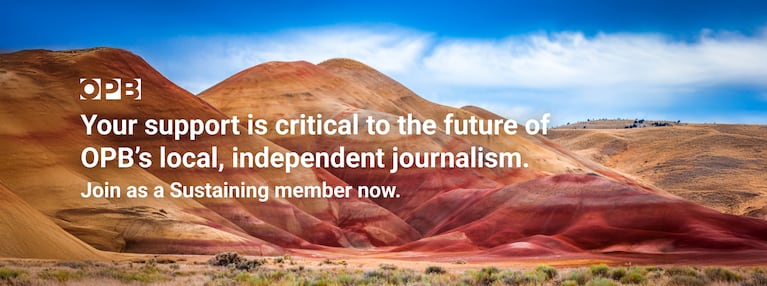Seven years after the historic eruption of Mount St. Helens, the mountain was finally opened again to climbers.
A team from The Seattle Times went to report. On the summit of the new crater rim, they saw something they weren't expecting: a vivacious woman on skis, wearing a red chiffon dress and a white pillbox hat.
Accompanying the woman in the red dress were five female friends who danced a can-can.
“After climbing the rugged mountain for four and a half hours,” wrote the reporter, “no one expected a party.”
Fast forward three decades: the annual Mother’s Day Climb of Mount St. Helens has become one of the Northwest’s most beloved outdoor recreation traditions — perhaps the most colorful, irreverent and playful day in the entire Cascade Range. Climb permits are always sold out each year, and since the tradition started an estimated 15,000-20,000 people have climbed Mount St. Helens in flashy dresses.
Yet few have heard of the original woman in the red chiffon dress and pillbox hat.
Her name was Kathy Phibbs. And she had a mission: get more women in the mountains — and do so in a colorful, creative and inspiring way.
With wit, charisma and dogged determination, Phibbs set a new example of mountaineering. She created opportunities for women to have fun, challenge themselves and become mentors to each other in the mountains. As a gay woman, she also created an inclusive community in an era of widespread discrimination around sexual orientation. She led women to the summit of Denali and some of the world’s highest peaks in the Andes and the Himalayas. But it was her grassroots leadership in her own backyard of the Cascades where she made her greatest contribution.
Tragically, her story was cut short and has gone untold too long.
Her first real mountain
When Phibbs was a high school senior she had a chance to climb Mount St. Helens — her first real mountain.
Before the May 18, 1980, eruption, St. Helens had been one of the most beloved Cascade peaks to climb. It rose 9,677 feet in a perfect symmetrical cone, so elegant that it was often compared to Japan’s Mount Fuji.
Northwesterners pointed to photos of the snow-capped St. Helens reflected in the glassy water of Spirit Lake, framed by towering old-growth trees, and proudly thought it was even prettier than Fuji.
Even the earliest legend of St. Helens spoke of the mountain’s beauty. Known as Loowit, she had once been a woman so lovely that she caused two brothers, Wyeast and Klickitat, to fight over her. All three were turned into mountains. Today they're known by the names St. Helens, Hood and Adams.
Phibbs must have been both excited and anxious before her first attempt to climb a glaciated peak. But about a week before the climb, a group of students from the University of Puget Sound were caught in an avalanche while climbing St. Helens. Five were killed.
This news hit close to home. The family had moved from the East Coast for her dad, Philip Phibbs, to take the role of president of the University of Puget Sound in Tacoma, Washington. Now he had the sad duty of addressing the student body and calling the parents. Adding to this grief: He knew exactly what it felt like to lose a child. He and his wife, Gwen, had lost their young son.
Upset by the tragedy and concerned for his daughter’s safety, he told Kathy he didn’t want her to go up St. Helens.
When it came time for the climb, she snuck out of the house and climbed the mountain anyway.
Making her own path
In the fall of 1975, Phibbs arrived as a freshman at Pomona College in Southern California. There she met Ross Macfarlane, a transfer student. When Phibbs learned that Macfarlane had some experience rock climbing, she asked: “Do you have a rope?” Macfarlane nodded. “Do you have a car?” she asked. He shook his head no. Then she disappeared and returned shortly with another student in tow. “This guy has a car.”
“She had a bulldog personality,” Macfarlane recalled. With her witty humor and sharp zingers, she won people over. “A force of nature,” was a phrase several of her friends used to describe her.
One time Macfarlane and Phibbs agreed to take a group of classmates to practice rock climbing at a local crag. Phibbs, as usual, was in the lead. But somehow she lost the trail.
After bushwacking, the group was grumbling and ready to turn back.
“Wait here and I’ll go scout,” Phibbs told the group, and bounded into the brush.
Then, Phibbs’ voice came back, “This way! I found a cairn!”
The group shouldered their packs and hiked toward the direction of Phibbs’ voice.
They soon reached a cairn, a small pile of rocks to mark a route.
Phibbs had already bounced ahead. “Up here!” she shouted enthusiastically. “Another cairn!”
The group’s optimism picked up. They arrived at a second pile of rocks.
“Hey, up here!” Phibbs yelled. “Another cairn! This is it, we’re almost there!”
The group’s doubts evaporated. They pressed through the brush following Phibbs’s voice.
Phibbs raced ahead, stopping only long enough to grab rocks and create her own cairn.
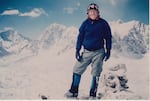
Kathy Phibbs, an accomplished mountaineer, climbed peaks in the Andes, Himalaya and Denali.
Kathy Phibbs collection
No, we’re with each other
Phibbs graduated from college on May 17, 1980. The next day Mount St. Helens erupted.
She had no idea what her future would hold, but she was certain of one thing: It would involve mountains.
The next year, she made a climbing expedition to Peru and Bolivia.
But after three years of trying to build her alpine resume to become a professional guide, she despaired that she hadn’t become a world-famous alpinist.
To make ends meet, she used her rope and rappelling skills — and her fearlessness of heights — to sweep chimneys and wash windows.
“Success as a climber wouldn’t have been so important if my career in window washing was, well, more fulfilling,” she wrote.
She and her college pal Macfarlane had shared many summits, but something was starting to shift for Phibbs. “She did a lot of climbing in mixed groups, and she saw the need to get more women out doing it for themselves,” Macfarlane said.
“We all had experiences of being with men who would just take charge, go on ahead or sort of try to take over for us,” said Kristen Laine, another climbing friend. “There was this assumption that we weren't strong enough, we weren't good enough, we couldn't do it as well as they could.”
When a group of guys would see Phibbs and her friends in the backcountry, they’d ask: “Are you ladies alone?”
“No,” they’d reply. “We’re with each other!”
“I had started climbing with women for all the normal reasons,” Phibbs wrote, “purity of style, greater challenge, and, of course, the relentless fun of it. It was a different game. We were on our own learning from each other and from what we could glean from books and overheard conversations at climber hangouts.”
In 1983, Phibbs and her close friends decided to see if there were more women who wanted to climb with women. They posted flyers near the University of Washington and started word-of-mouth. To their surprise, dozens of women showed up and packed into a small Seattle apartment.
A new grassroots group was launched: Women Climbers Northwest.

Kathy Phibbs (left) helped create a community of female climbers in the 1980s.
Kathy Phibbs collection
Meeting Miss Dish
“Various male companions had taught me so much in the early years of my climbing career,” Phibbs wrote. “Now I yearned for a woman to continue the process.” She looked for a female mentor. Not finding one, she invented one.
With a love of history, Phibbs looked to the past for inspiration. She knew about the women of the Victorian era who climbed mountains in full-length wool dresses, petticoats, lace-up patent leather boots and wide-brimmed bonnets.
Her version was something like that. Phibbs described her as “the most astonishing little old lady” dressed in a white pillbox hat with fishnet veil, a red chiffon shift and cape with gold lamé, rhinestone butterfly-wing glacier goggles, a mink stole, spotless white tennis shoes and a combination ice ax/umbrella. A cross, perhaps, between a Victorian climber and Mary Poppins.
Her name was Miss Dish.
“Miss Dish was a very proper woman alpinist who was trying to teach life lessons to ‘That Kathy Girl,’ as well as all of those other young whippersnappers who needed molding to learn to take their proper place in the alpine community,” Macfarlane explained.
Miss Dish became Phibbs’ way of criticizing climbing culture. In her writing to the Women Climbers Northwest community, she used Miss Dish to proclaim: “If you don’t have time to do it right (with good manners) don’t do it.” Manners weren’t just etiquette, but rather a reverence for the mountains themselves.
Through Miss Dish, Phibbs would call for a celebration of sisterhood in the mountains, and start to define a style of mountaineering in stark contrast to the “self-importance on the part of climbers, grunting through the mountains with no thought or sight of anything other than the summit.”
She wrote, “Though it is important that we reach the top (because that’s where lunch will be), this expedition’s goals are not assault and conquest.”
Phibbs organized all-women climbs in Washington’s North Cascades, a cluster of sharp peaks she called her “beloveds.”
The climbs began to take on a unique style. They became celebrations, expressions of joy for being in the mountains. Good food was mandatory. And the outfits colorful. Phibbs loved to pack plastic flamingos to use in summit shots.
Within the frivolity was a strong feminist message. "We wanted to say: ‘Yes, we're women and we're going to make fun of what you think we should be,’” Laine explained. “'And we're going to be strong in pearls. We're going to be strong in a dress.'"
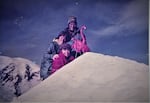
Kathy Phibbs and friends often packed flamingos to mountain summits.
Kathy Phibbs collection
Mother's Day and dirtbag climbers
When Phibbs’ friends saw her on the front page of The Seattle Times on the summit of St. Helens in a red chiffon dress and white pillbox hat, it was hardly a surprise to them.
“That Kathy Girl,” Annette Frahm laughed. “We figured she’d do something like that.”
But the wearing of dresses on St. Helens hadn’t originally been a celebration of Mother’s Day. “It had nothing to do with moms,” Frahm explained. “It was the last weekend you could climb without a permit. It just happened that was the day.”
“We were dirtbag climbers,” Laine said. “And we didn’t want to have to pay for a permit!”
The members of Women Climbers Northwest invited their friends, and friends invited friends. They allowed boyfriends and husbands along — if they wore dresses.
“Every time we went,” Laine said, “people were like, ‘Oh, that's great. I love seeing you all dressed up.’ We would invariably say, ‘You can do it, too. Come join the party!’"
And eventually, they’d see other climbers in dresses that they didn’t know. It’d caught on.
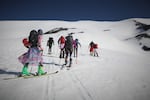
Eventually the popularity of skiing up Mount St. Helens in colorful dresses caught on.
Ian McCluskey / OPB
Sisterhood of summits
Despite the gaudy thrift store dresses and kitsch plastic flamingos, Phibbs took her climbing seriously. She led a group of women up North America’s highest mountain, Denali. In 1989, she led an all-women expedition up the 23,000-foot Himalayan peak Pumori near Mount Everest, known in the Sherpa language as “Mountain Daughter.”
On the centennial of the first female ascent of Mount Rainier, Phibbs organized an all-women climb. Fay Fuller, a Tacoma school teacher, had been the first in 1890. Because of the dress code of the era, she was expected to wear a dress. In homage, Phibbs wore a dress. She led 33 women to the top of the Northwest’s highest mountain.

To commemorate the first female ascent of Mount Rainier, Kathy Phibbs wore a dress.
Kathy Phibbs collection
In the expansiveness of the mountains, Phibbs found a freedom to be her true self. In doing so, she created a safe space for women to be themselves. “As lesbians we really valued who she was,” said her friend Rachel da Silva.
“She didn't really want to be the actual teacher as much as she wanted to support people to be the best they could. It was more like a gentle encouragement,” said her friend Frahm. “Then it felt OK to be who you were because she was being who she was.”
“She got me to perform at a higher level and take more risks and to be successful where you feel like you’re capable of doing more than you’ve done in the past,” said her friend Sally Kentch. “It’s not a role model. It’s deeper. It’s more internal than that.”
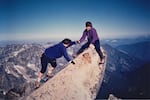
Kathy Phibbs helped women reach new heights.
Ruth Nielson / Women Climbers Northwest
Dragontail
In 1991, Phibbs and a close friend went ice climbing on a peak called Dragontail in Central Washington’s Stuart Range.
Phibbs’ friend Hope Barnes had just completed her doctoral dissertation, a perfect excuse for a celebratory trip to the mountains.
They headed into the backcountry of the Alpine Lakes Wilderness to pristine Colchuck Lake and set up base camp. The day was cold and clear, good conditions for an ice climb. The route they’d picked pitched up three couloirs. An advanced climbing route, to be sure, but within their many years of experience.
Barnes was an Olympic rower and a competent and respected rock climber, mountaineer and backcountry skier.
The two of them were cautious and conservative climbers by nature. Many times Phibbs had turned back when conditions didn’t feel right. She was one of the first to use trekking poles, Frahm recalled, so she could save her knees. Phibbs had always told her friends she wanted to become an “old goat” of the mountains.
Their plan was to bask in the silence and isolation of the snowy backcountry. They’d added an extra day to when they told their partners to expect their return.
They were in no hurry, with no objective other than the pure joy of climbing.
Then, in the second couloir, ice, or snow, or an avalanche broke loose. It swept them off their holds, and they fell.
What happened next is a scene that was pieced together by the accident report and what her friends described witnessing when they arrived days later. It haunts them, still.
Barnes had sustained a blow to the head hard enough to crack her helmet and knock her unconscious. Although bleeding of her own wounds, Phibbs tended to Barnes. She arranged the climbing rope and pulled Barnes onto it to get her off the snow and make her as comfortable as possible. She wrapped a spare coat around Barnes, to delay inevitable hypothermia. With broken ribs and broken femur, Phibbs started crawling back downhill to get help.
“She died trying,” Laine said. “I know she died trying to save herself and her friend.”
Both women were 33.
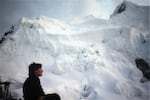
The world lost an inspiring woman of the mountains when Kathy Phibbs died in 1991
Ross Macfarlane
Return of the red dress
More than 30 years since Kathy Phibbs stood on the rim of St. Helens in a red chiffon dress and pillbox hat, her friends reunite — in tutus and dresses — to honor the memory of “That Kathy Girl.”
Helping organize the group is Colleen Hinton; she never got to meet Phibbs, but now carries on her role as director of Women Climbers Northwest.
Phibbs’ parents, Phil and Gwen, come to support this tribute climb and join her old friends at the trailhead.
“It’s a very moving experience to see and recreate the kind of life Kathy led and the spirit that she had,” Phil says. Gwen stands beside him and squeezes his arm. “I think it gives a sense of closure to what happened to Kathy that’s weighed on us all these years.”
A colorful line of climbers start at the parking lot and snake through the woods and up the snowfield, sparkling sequins.
At the top, a few dozen folks rest and snack. A couple “summit sodas” are cracked and a Champagne cork pops, but this “party” is fairly low key. Everyone there has had to earn their spot, step by step, for 6 miles and up the 5,500-foot elevation gain. Even the 20-somethings are content to chill in the sun.
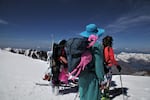
Friends of Kathy Phibbs look into the crater of Mount St. Helens during a climb in her memory.
Ian McCluskey / OPB
Phibbs’ friends stick the pink plastic flamingos in the snow. They snack on ginger snaps, Phibbs’ favorite. They toast. From a backpack emerges the original red dress — chiffon and gold lamé trim.
Frahm offers to try it on and poses on the crater rim, the breeze rippling the same fabric as it had on Phibbs that spring day in 1987. But it isn’t the same, and everyone can feel it, but don’t want to say it out loud.
They gaze into the vast crater, silent, feeling the welling up of grief.
Macfarlane casually points out that the elevation we are at was nothing more than a rest break on the original climb. “Over there is the Dogs Head,” he says, pointing his ski pole. I can tell that he is seeing the mountain two ways at the same time: what it is and what it was.
“For me it’s always a bit of a ghost mountain,” Macfarlane said. “When you get to the rim and look into that giant crater it’s beautiful but there’s also this sense of loss, of what’s missing. A double sense of loss because of this great friend who put a stamp on it.”
At the summit of St. Helens, dozens of other people celebrate. They take turns posing with a cardboard sign that reads: Happy Mother’s Day. They hand each other their phones and say, “Take one of me.”
Few here, if any, know about Phibbs.
But Phibbs’ story, and Mount St. Helens itself, is not simply about what is no longer there, but what remains.
And what remains of the day is to do what “That Kathy Girl” would do: tilt head to the sun, grin, feel the flutter of chiffon, then push off on ski poles, and embrace the letting-go sensation of carving easy turns in slushy snow on a promising spring day.
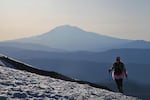
A woman in a pink tutu climbs Mount St. Helens on Mother's Day, following a tradition started by Kathy Phibbs.
Ian McCluskey / OPB


